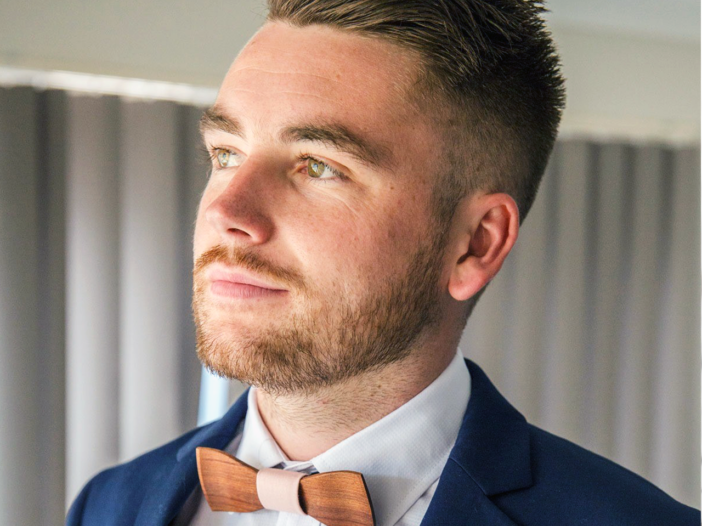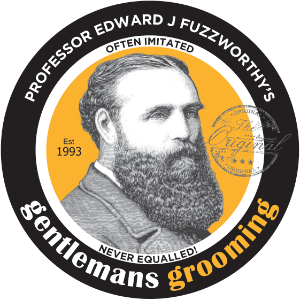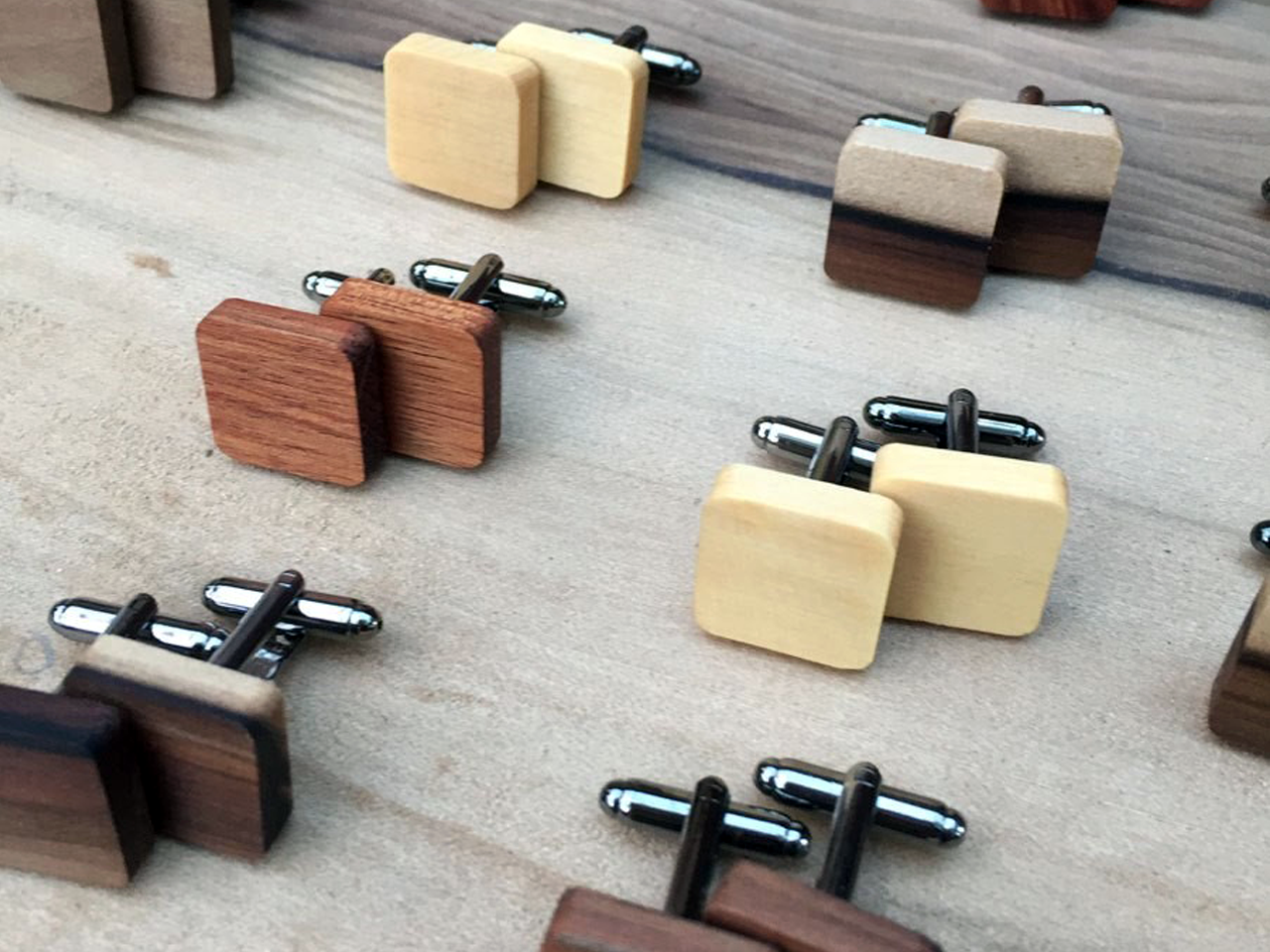
Eco-Friendly Style: Edwoods
True men’s style means knowing when to take chances. Bow ties can be fun, but too often they’re identified with academia or stuffy professions. Even if you ARE a professor, solicitor, etc., the handmade wooden bow ties and cuff links created by Hobart-based Edwoods Timber Crafts can add flavor to an otherwise conservative wardrobe without raising (too many) eyebrows. They’re suitable for work, play, and, as you’ll read below, weddings.
When Simone and Ted Chatain were planning their outdoor wedding in 2014, they envisioned a hard-to-define aesthetic – rustic but fashion-forward.
As the couple brainstormed, amateur woodworker Ted came up with an idea that ticked their boxes – crafting handmade bow ties for himself and all his groomsmen from wood. Women in the wedding party received handmade wooden brooches. The response was so positive, the couple decided to launch a side hustle, creating unique bow ties to sell at local craft markets. They always sold out.
The wedding was in Canberra (Simone’s home), but a few years later, the couple relocated to Hobart, where Ted was born (His dad’s American and he’s spent about half his life in the U.S.).
As the family grew (their children are 12, 5 and 2), they continued to pursue this side project, with Ted handling web development and production in a backyard workshop; Simone helped source timber and fabric focused on refining product design. In 2018, Ted stepped aside from his career as a graphic designer to pursue Edwoods fulltime. For now, Simone is keeping her fulltime job, while Ted’s focusing on growing the business, which they believe is still in its earliest phase.
We recently Skyped Ted at the family’s combination home/office/ workshop in Hobart.
Q: You make the ties yourself. What’s involved in the process?
A: “My workshop is nothing fancy; it’s just a shed in the backyard. Making the bowties is a 100% hands-on process which involves cutting down the wood with the bandsaw, followed by hand and belt sanding. Then we take the ties to a small studio, also in our yard, for a final sanding, waxing, and clear coating to make them waterproof.”
Q: When a friend shared Edwoods’ website with the team at Beauty and the Bees/Professor Fuzzworthy, the immediate response from everyone involved was – “I want one (or more)!” You must have collectors?
A: “We have a few collectors who visit our booth. One guy who shops at our booth in Salamanca Market has collected about 20 pieces.
But the majority of our market is from mainland Australia and internationally. Tasmania is the holiday island for the rest of Australia and eco-tourism is a massive part of the economy here. It has a bit of a small-town vibe. International travelers account for a large section of our sales.
Local customers currently don’t make up a big part of our market.”
Q: How do you choose the ecofriendly materials you use – Huon pine, myrtle, oak, beech, sassafras, etc.? What makes Tasmania-sourced wood special?
A: “Initially, we did research and reached out to local Tasmanian timber mills and craftsmen who worked with Tasmanian timbers. We were looking for quality pieces of wood with nice grain work. Simone helped me to source our first batches of wood, including timbers like Huon Pine*. It’s our most popular material, with the most aroma.
And, because of protection status, Huon Pine isn’t felled anymore. So sourcing involves using logs felled centuries ago or from old tree stumps. We have found wood at local timber mills and from backyard craftsmen who donate ‘offcuts.’
All these forms of sourcing are a kind of a win/win for both us and the environment. Two other Tasmanian timbers we use are Tasmanian Blackwood (aka Australian Blackwood) and Sassafras. As the name suggests, Blackwood is darker and perfect for more formal occasions, like weddings and formals. Sassafras is a mix of pale yellow with dark grains running throughout, caused by a fungus that naturally stains the timber as it grows.
Each piece is unique and we never use paint or stain, just beeswax, which I melt and buff into the grain multiple times to create natural protection. We’ll never go down the path of mass production.”
Q: What about fabric?
A: “Fabric options have become increasingly important and we continue to add more all the time. Every bow tie is then given its own unique identity with a replaceable fabric centerpiece, making each bow tie an individual expression of its wearer. So you can have one or two different ties with almost limitless fabric options. We buy from local craft stores, when possible. Clients can even select wood and fabric to match pocket squares.”
Q: How do weddings fit into your business plan?
A: “They make up about 25% of our business, and that’s one aspect that has held steady throughout COVID. We do about 30-40 weddings a year and demand has been higher lately. A lot of people are in the process of planning their big event for when things get better.
When we work for wedding clients, we stress that they have many options. The bow ties and cufflinks for the groom and groomsmen can match and we can use conservative colors, like dark blue, but sometimes they’ll request brighter colors and more of a mix/match look, especially for the groomsmen and any children participating in the wedding.”
Q: With COVID-19 shutting the world down, and Salamanca Market closed until September, what does your future look like in terms of sales and marketing?
A: “It’s tricky, but it’s been a bit of a blessing because we’re using the COVID time to ‘upgrade’ the website and to focus on more product development, including adding initialing and engraving for cufflinks.
Looking to next year, we’ll introduce more new products and (hopefully) add a few employees to both help in the workshop and with selling at market stalls.
With new products we’re developing more cufflink options, plus hair bows for little girls, tie clips and other menswear accessories. They’re a work in progress. To better target our market, we’ll be launching an accessories and ideas section. We’ll post new one-off concepts, gauge what’s popular and develop those products. As I mentioned, up until now our market hasn’t been local, it’s been 50% international and 50% Australian tourism. When Salamanca and other markets reopen, however, due to border restrictions, it will basically be 100% local tourism.”
Q: Looking ahead, are you aiming to place your products in more brick & mortar shops?
A: “Right now, Edwoods is in about 10 retail locations, including a location in East Asia and Europe, but none in North America at this point. So that’s a goal. Also, over the next few years, we want to focus on getting more involved with finer menswear stores and I would like to develop a higher-end model of what we produce. With just myself crafting our products at the moment, and the time and care given to each unique piece, our only limit is hours in the day.
We’re definitely just getting started.”
*Huon Pine. A species of conifer native to the wet southwestern corner of Tasmania. Slow growing, they can live for thousands of years.










Leave a Reply